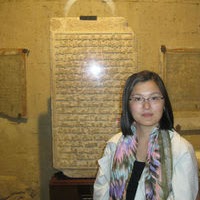Hui Chen Lu
age ~56
from Edison, NJ
- Also known as:
-
- Hui Zhou Lu
Hui Lu Phones & Addresses
- Edison, NJ
- Bridgewater, NJ
- Fremont, CA
- 102 E Charleston Rd, Palo Alto, CA 94306 • 6506309757
- Westmont, IL
- Union City, CA
- Santa Clara, CA
- San Jose, CA
Work
-
Company:San francisco state university - San Francisco, CAJan 2008
-
Position:Biology lab technician
Education
-
School / High School:Golden Gate University- San Francisco, CA
-
Specialities:Master of Science in Human Resource
Us Patents
-
Method And Apparatus For Authentication Of Session Packets For Resource And Admission Control Functions (Racf)
view source -
US Patent:8108677, Jan 31, 2012
-
Filed:Jun 27, 2007
-
Appl. No.:11/823620
-
Inventors:Thomas Wayne Anderson - Naperville IL, US
Igor Faynberg - East Brunswick NJ, US
Hui Lan Lu - Marlboro NJ, US
Zachary Zeltsan - Bronx NY, US -
Assignee:Alcatel Lucent - Paris
-
International Classification:H04L 9/32
H04L 29/06 -
US Classification:713172, 713159, 726 2, 726 3
-
Abstract:The invention that addresses the problem of authentication of the transport packet stream (which constitutes a flow within a session), which has been admitted into a managed packet network. Authentication and the subsequent policing of the flows supporting an identified client's authorized service prevent a large class of denial of service attacks described below. Specifically, the invention addresses two different matters: 1) key distribution and management 2) various forms of using a shared key for the authentication of transport packets on the user-to-network-interface (UNI).
-
Method And Apparatus For Waiving Noise Violations
view source -
US Patent:20040049745, Mar 11, 2004
-
Filed:Sep 6, 2002
-
Appl. No.:10/236840
-
Inventors:Mohammed Rahman - Santa Clara CA, US
Langya Yang - Sunnyvale CA, US
Yongjun Zhang - Sunnyvale CA, US
Victor Leung - Sunnyvale CA, US
Hui Lu - Sunnyvale CA, US
Shunjiang Xu - Sunnyvale CA, US
Rambabu Pyapali - Cupertino CA, US
Peter Lai - San Jose CA, US
Chin-Chang Wu - Saratoga CA, US -
Assignee:Sun Microsystems, Inc.
-
International Classification:G06F017/50
-
US Classification:716/004000
-
Abstract:The present invention describes a method and an apparatus for waiving noise violations during semiconductor integrated circuit design. The noise violations in a circuit area (e.g., an individual cell, block of cells or the like) are identified using a threshold look-up table. The threshold look-up table includes different thresholds for each circuit area. The threshold look-up table is generated using various cell related information including practical noise handling limits of each cell that can be higher than traditional noise limits. The information in the threshold look-up table helps eliminate benign noise violations and a new noise report is generated. The new noise report incorporates the practical noise handling capabilities of the cell under analysis and identifies actual noise violations in the semiconductor integrated circuit.
-
Converging Error-Recovery For Multi-Bit-Incrementing Gray Code
view source -
US Patent:7149956, Dec 12, 2006
-
Filed:Feb 9, 2004
-
Appl. No.:10/708095
-
Inventors:Hui Lu - Union City CA, US
-
Assignee:Pericom Semiconductor Corp. - San Jose CA
-
International Classification:H03M 7/16
-
US Classification:714809, 341 97, 341 98, 377 34, 714819
-
Abstract:An L-bit gray-code input value can change by more N bits at a time. The lower N bits of the input are stored as a received least-significant-bits (LSB) while the upper bits are stored as a received most-significant-bits (MSB). A stored register holds the corrected, stored MSB and LSB for use by the receiver. When the received and stored MSB's mis-match, the new MSB is stored and the stored LSB is generated so that the stored register contains the smallest possible value with the new MSB. When the received and stored MSB's match, the full L bits are compared. When the received word is larger than the stored word, the largest mis-matching bit in the LSB is found, and bits above this are copied from the received LSB to the stored register, while lower bits are generated to produce the lowest value. Repeating the process converges the result.
-
Organic Light-Emitting Diode Display With Single Anti-Node Optical Cavities
view source -
US Patent:20220271254, Aug 25, 2022
-
Filed:Jan 5, 2022
-
Appl. No.:17/569384
-
Inventors:- Cupertino CA, US
Michelle C. Sherrott - Santa Clara CA, US
Steven J. Brewer - Atlanta GA, US
Ping Kuen Daniel Tsang - Taoyuan, TW
KiBeom Kim - Cupertino CA, US
Hui Lu - Cupertino CA, US
Siddharth Harikrishna Mohan - Aurora IL, US -
International Classification:H01L 51/52
-
Abstract:An electronic device may have a display such as an organic light-emitting diode (OLED) display. The OLED display may have an array of OLED pixels that each have OLED layers interposed between a cathode and an anode. The pixels may be microcavity OLED pixels having optical cavities. The optical cavities may be defined by a partially transparent cathode layer and a reflective anode structure. The distance between the partially transparent cathode layer and the reflective anode structure for a pixel may be selected such that light at the wavelength emitted by the pixel forms a standing wave between the anode and the cathode. The standing wave may have only one anti-node and the emissive layer for the pixel may be aligned with that one anti-node. To mitigate short circuits, a roughness reduction layer and/or short-circuit-reducing layer having a high sheet resistance may be formed between the anode the OLED layers.
-
Organic Light-Emitting Diode Displays With Reflectors
view source -
US Patent:20190067394, Feb 28, 2019
-
Filed:Aug 27, 2018
-
Appl. No.:16/114039
-
Inventors:- Cupertino CA, US
Cheng Chen - San Jose CA, US
Chien Lu - New Taipei City, TW
Chih-Lei Chen - Tai Chung, TW
Chin Wei Hsu - Hsinchu, TW
Hui Lu - Cupertino CA, US
KiBeom Kim - Cupertino CA, US
Lun Tsai - Zhubei, TW
Meng-Huan Ho - San Jose CA, US
Nai-Chih Kao - Taoyuan, TW
Pei-Ling Lin - New Taipei City, TW
Rui Liu - San Jose CA, US
Shan-Jen Yu - Taoyuan, TW
Wendi Chang - Santa Clara CA, US
Yusuke Fujino - Taoyuan, TW -
International Classification:H01L 27/32
H01L 51/50
H01L 51/52
H01L 51/56
G09G 3/3225 -
Abstract:A display may have an array of pixels formed from organic light-emitting diodes and thin-film transistor circuitry. Each pixel may include organic layers interposed between an anode and a cathode. The organic layers may emit out-coupled light that escapes the display and waveguided light that is waveguided within the organic layers. A reflector may be placed at the edge of the organic layers to reflect the waveguided light out of the display. The reflector may be located within a pixel definition layer and may be formed from metal or may be formed from one or more interfaces between high-refractive-index material and low-refractive-index material, The reflector may be formed from an extended portion of the pixel anode. The reflector may be formed from light-reflecting particles that are suspended in the pixel definition layer.
-
Link Management Method And Physical Device
view source -
US Patent:20180088866, Mar 29, 2018
-
Filed:Sep 22, 2017
-
Appl. No.:15/713144
-
Inventors:- Shenzhen, CN
Hui LU - Santa Clara CA, US -
International Classification:G06F 3/06
-
Abstract:This application provides a link management method. The physical device includes a first memory that stores a tail pointer of a link and a second memory that stores a head pointer of the link, and the physical device supports one time of enqueue processing and one time of dequeue processing in one clock cycle. The method includes: when a first link is not empty before the enqueue processing, modifying, by the physical device, a first tail pointer that is of the first link and that is in the first memory; and when a second link is not empty after the dequeue processing, modifying, by the physical device, a second head pointer that is of the second link and that is in the second memory.
-
Hybrid Network Management
view source -
US Patent:20150043382, Feb 12, 2015
-
Filed:Aug 6, 2014
-
Appl. No.:14/453054
-
Inventors:- Princeton NJ, US
Hui Zhang - Princeton Junction NJ, US
Cristian Lumezanu - East Windsor NJ, US
Junghwan Rhee - Princeton NJ, US
Guofei Jiang - Princeton NJ, US
Hui Lu - West Lafayette IN, US -
International Classification:H04L 12/24
H04L 12/46 -
US Classification:370254
-
Abstract:Method and systems for controlling a hybrid network having software-defined network (SDN) switches and legacy switches include initializing a hybrid network topology by retrieving information on a physical and virtual infrastructure of the hybrid network; generating a path between two nodes on the hybrid network based on the physical and virtual infrastructure of the hybrid network; generating a virtual local area network by issuing remote procedure call instructions to legacy switches in accordance with a network configuration request; and generating an SDN network slice by issuing SDN commands to SDN switches in accordance with the network configuration request.
Name / Title
Company / Classification
Phones & Addresses
Vice-President
Premium Technology Inc
Financial Services · Custom Computer Programing Prepackaged Software Services · Computer Sales · Computer & Software Stores
Financial Services · Custom Computer Programing Prepackaged Software Services · Computer Sales · Computer & Software Stores
32 Broadway SUITE 1201, New York, NY 10004
2128555511, 2126589101
2128555511, 2126589101
Zucoo LLC
690 W Fremont Ave, Sunnyvale, CA 94087
3241 Vineyard Pkwy, San Jose, CA 95135
3241 Vineyard Pkwy, San Jose, CA 95135
HY GENSEN CORP
2030 Imperial Engle Pl, Kissimmee, FL 34746
45 Division St 218, New York, NY 10002
45 Division St 218, New York, NY 10002
Resumes

Hui Lu
view source
Hui Lu
view source
Hui Lu
view source
Hui Lu
view source
Hui Lu
view source
Hui Lu
view sourceLocation:
United States
Youtube
Googleplus

Hui Lu

Hui Lu
Education:
Peking University Health Science Center

Hui Lu

Hui Lu

Hui Lu

Hui Lu

Hui Lu

Hui Lu
Flickr

Hui Lu
view source
Hui Lu
view source
Hui Lu
view source
Hui Jie Lu
view source
Hui Lu
view source
Hui Yee Lu
view source
Hui Lu
view source
Hui Lu
view sourcePlaxo

Hui Lu
view sourceStella, obtained my master degree in Logistics in Sydney Australia. I was back SHA and joined DHL 3 years ago. Years studying and living experience broad my... Stella, obtained my master degree in Logistics in Sydney Australia. I was back SHA and joined DHL 3 years ago. Years studying and living experience broad my eyes and heart indeed!
I am a traditional Chinese girl with a little bit aggression. Romantic, intelligent, pure and kind...
I love my...
Myspace
Get Report for Hui Chen Lu from Edison, NJ, age ~56















